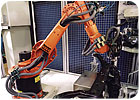
Automotive supplier Dynamit Nobel Kunststoff GmbH (Weissenburg, Germany) assembles a range of different products at its plant in Pappenheim, Germany. Among these is the front end for the Ford Focus, a structural component that is manufactured using hybrid injection-molding techniques to reduce the number of steps required to produce what is a fairly complex assembly.
Midway through the manufacturing process, brackets have to be attached to the framework with screws. In the past, Dynamit Nobel Kunststoff used a linear screw-driving unit to perform this task. However, the system was susceptible to malfunctions due to the length of its conventional screw-feeding system. In addition, because of its limited range of motion, the system was unable to install all the screws on some of the company’s more challenging assemblies.
To solve these problems, Dynamit Nobel Kunststoff installed a KR 15 six-axis robot from KUKA Robotics Corp. (Clinton Township, MI) to screw the brackets onto the assemblies in a fully automated workcell.
To begin the process, an operator loads the frame and eight brackets onto one of two fixtures on a rotary indexing table-an arrangement that allows the robot to work on one front-end assembly while the operator is loading the parts for a second. Once the parts have been loaded, the table rotates 180 degrees and presents the parts to the robot. The robot then secures the brackets on the front-end framework using one screw for each bracket. A mechanical screw presenter provides the KR 15 robot with the correct fasteners from a fixed position.
In their final position, each screw must project a set distance from the front-end framework, so that it will be easier for Ford workers to attach it during final vehicle assembly. To achieve this orientation, the robot first drives each screw until it reaches a specified torque value. It then unscrews each fastener until it reaches the requisite distance.
In the event the robot receives a defective screw, or one that fails to attach a bracket correctly, the robot will try to make the screw work two times then drop it in a reject receptacle. If the robot fails to attach a bracket with a second screw-in which case the problem may be the bracket itself-it will go on to attach the remaining brackets and log an error signal. An operator will then try to attach the bracket manually.
According to Dynamit Nobel Kunststoff, the new automated cell has increased both throughput and quality. Throughput, in particular, is twice as great as it would have been if the company had elected to have the brackets installed manually.
For more on robotic assembly, call 866-873-5852 or visitwww.kuka.com/usa.